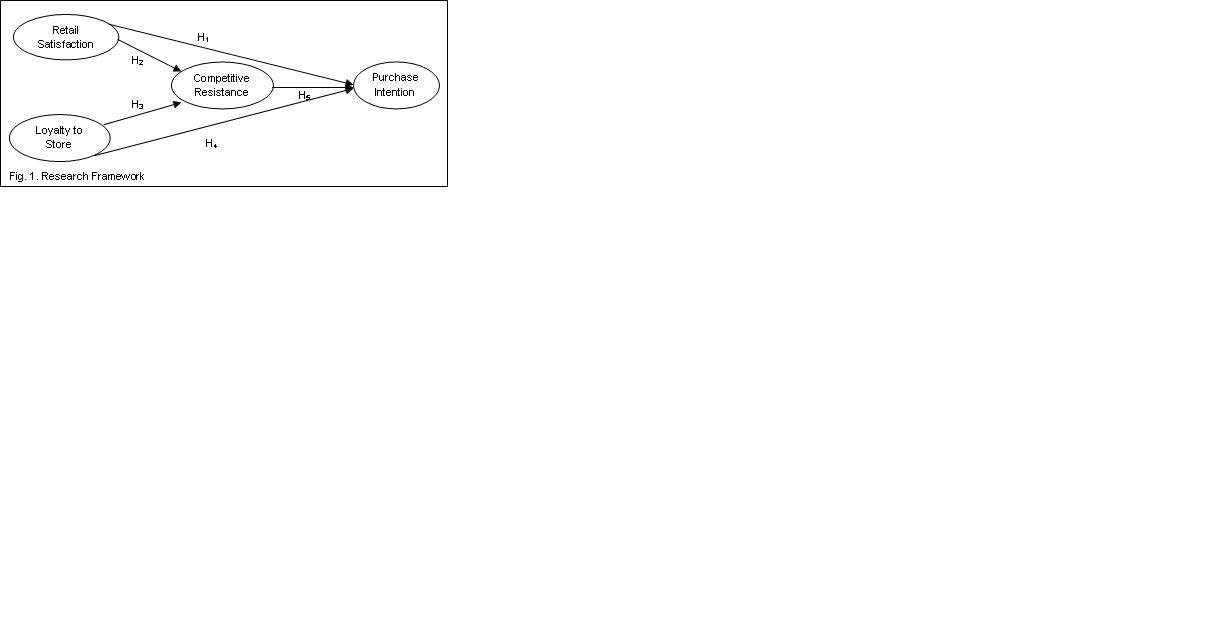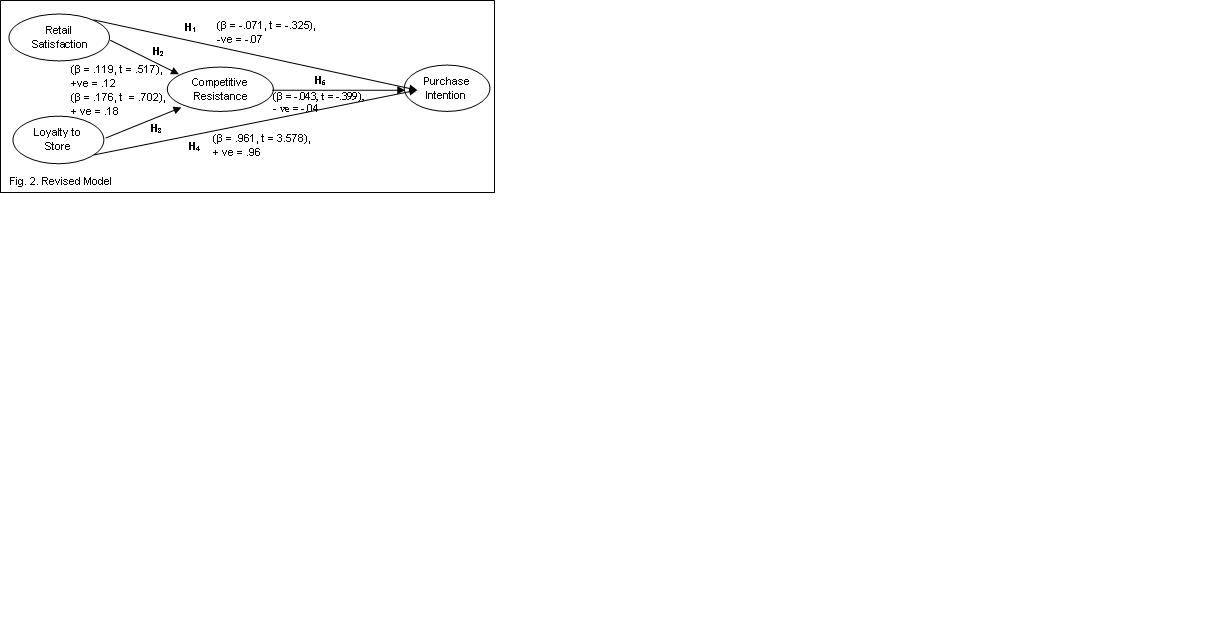-
Paper Information
- Next Paper
- Previous Paper
- Paper Submission
-
Journal Information
- About This Journal
- Editorial Board
- Current Issue
- Archive
- Author Guidelines
- Contact Us
American Journal of Economics
p-ISSN: 2166-4951 e-ISSN: 2166-496X
July, 2012;
doi: 10.5923/j.economics.20120001.16
Store Loyalty, Retail Satisfaction and Competitive Resistance towards Purchase Intention
Rabiatul Adawiyah Ma’rof 1, Nik Kamariah Nik Mat 1, Umi Kartini Rashid 2, Juzaimi Nasuredin 2, Fitriah Sanita 1
1Othman Yeop Abdullah Graduate School of Business, Universiti Utara Malaysia, Sintok, 06010, Malaysia
2Universiti Tun Hussein Onn Malaysia, Parit Raja, Batu Pahat, 86400, Malaysia
Correspondence to: Rabiatul Adawiyah Ma’rof , Othman Yeop Abdullah Graduate School of Business, Universiti Utara Malaysia, Sintok, 06010, Malaysia.
| Email: |  |
Copyright © 2012 Scientific & Academic Publishing. All Rights Reserved.
Abstract This paper explores the factors that influence the consumers’ intentions towards purchasing behaviour. Specifically, the objective of this study is to determine the relationships between retail satisfaction, loyalty to the store and competitive resistance toward purchase intention among the staff of a university in the North of Malaysia. All variables were measured from developed instrument using 7-point interval scale. The exogenous variable are retail satisfactions (8 items), loyalty to the store (9 items) while endogenous variables are competitive resistance (2 items) and purchase intention (2 items). A total of 103 staffs, based on random sampling method selected from various age, gender, education and income, participated in this study. The instrument is validated using exploratory factor analysis (EFA) resulting in three similar components as the exogenous. The data was then analysed using Structural Equation Modeling (SEM). The result shows that the goodness of fit indices of structural equation model are achieved at GFI=0.915, P-value=0.087, RMSEA=0.057 and ratio (cmin/df) =1.316. The finding supports one significant direct effect in the revised model, thus supporting the hypothesis regarding store loyalty is positively related to purchase intention (β=0.961, CR=3.578, p<0.001). The structural model explains 80.7 per cent variance in purchase intention. The result is discussed in the perspective of consumers’ loyalty towards purchase intention.
Keywords: Keywords Competitive Resistance, Loyalty, Purchase Intention, Retailing, Retail Satisfaction
Article Outline
1. Introduction
- THE growing economic crisis around the world in the recent years leads to the aggressive competitive defencestrategies among the companies in the economic environment. For instance, hypermarkets which targeted low to middle income consumers compete aggressively in term of pricing strategies. In Malaysia, between 2004 and 2009, nominal per capita GDP increased by 6.8% annually, with an average monthly gross household income increased by 4.4% per year from RM3, 249 in 2004 to RM4, 025 in 2009[1]. As a result, the share of real private consumption in GDP increased steadily from 43.8% in 2000 to 53.5% in 2009, with expenditure on food and non-alcoholic beverages formed the largest component, accounting for about 23% of total household expenditure. As such, it can be evidenced that consumers are spending more but deliberately, in spite of the current economic situation. Not only they will look upon the stores which offer low prices, but also those providing multiple benefits, such as free parking, loyalty card andmany more attractive alternatives. Therefore, after purchasing products, consumers have mind considerations that will influence their purchase intentions for the future.
2. Literature Review
2.1. Retail Satisfaction and Purchase Intention
- According to Westbrook[2], retail satisfaction consists of two or more underlying satisfaction dimensions including satisfaction with the salesperson, the product assortments, the store and others facet of the retail environment. Reynolds & Arnold[3] then define retail satisfaction as the customer's emotional reaction to the evaluation of his/her experience with the retailer and the salesperson.Past studies investigating the relationship between retail satisfaction and purchase intention has found significant relationship in fast food restaurant[4], in the performing arts[5], and in the airline industry[6]. And within the retail literature,[7],[8] undertook an empirical test of thereciprocity between retail satisfaction and purchase intention. Using the Structural Equation Modeling (SEM), they found that purchase intention was directly and significantly affected by retail satisfaction. Hence, the following hypothesis is proposed: H1: Retail satisfaction has a positive direct effect on purchase intention
2.2. Retail Satisfaction and Competitive Resistance
- While Tse & Wilton[9] proposed definition of satisfaction as the customer’s response to the evaluation of the perceived discrepancy between prior expectations and actualperformance of the product as perceived after its consumption, Reynolds & Arnold[3] defined competitive resistance as the customer's tendency not to shop elsewhere if the price is lower or if the brand/ style/ size desired is not available at the particular store. Based on the above definitions and discussion on retail satisfaction and competitive resistance, several researchers have established significant direct relationship between retail satisfaction and competitive resistance in marketing research[10],[11]. Furthermore, Walsh et al.,[12] found that retail satisfaction in retail industry provides significant direct effect toward competitive resistance. Therefore, another hypothesis can be put forward as:H2: Retail satisfaction has a positive direct effect on competitive resistance.
2.3. Store Loyalty and Competitive Resistance
- Competitive resistance results from a strong commitment to a specific object (e.g., a brand), and is thought to be based on a number of cognitive theories such as biased cognitive responses, self-perception theory and self-persuasion theory [13]. Thus, competitive resistance is defined as thecustomer's tendency not to shop elsewhere if the price is lower, or if the brand/style/size desired is not available at the particular store.Prior research suggests that loyalty leads to increased competitive resistance among customers. For example, loyal customers are often willing to pay premium prices[14], are not as likely to switch to competitors as a result of competitive marketing efforts[14], and have lower price elasticities[15]. Further, although situational factors may drive some consumption decisions and weaken the loyalty-resistance relationship, theory and prior empirical evidencesuggests that competitive resistance is a direct outcome of customer loyalty[16]. Thus, it is postulated that:H3: Store loyalty has a positive direct effect on competitive resistance
2.4. Store Loyalty and Purchase Intention
- Based on Bloemer & Ruyter[17] store loyalty can be defined as non-random behavioural response (revisit), expressed over time, by some decision-making unit with respect to one store out of a set of stores, which is a function of psychological (decision making and evaluative) processes which results in brand commitment. According to[18], besides buying more, loyal customers reported that they would recommend the retailer to others (word-of-mouth), would shop for a variety of products, would forgive occasional mistakes and would not shop from the competitor. Hence, word-of-mouth provides vital information about a firm to consumers that often times helps consumers decide whether or not to patronize a firm[19], and therefore leads to the extension of purchase intention among the consumers. Past studies suggest that the best retailers' assets are having long-term loyalty consumers who refuse to move to the other stores due to emotional connection with the outlets[20], which finally serve as a positive improvement which resulted in the repurchase by the consumers[21]. Hence, the following hypothesis is proposed:H4: Store loyalty has a positive direct effect on purchase intention
2.5. Competitive Resistance and Purchase Intention
- Competition is one of main problems that faced by the retailers. In order to resist the competitors, the retailers might issue loyalty cards for their customers as a part of loyalty programs, by which, loyalty programs can also enhance loyalty where their effectiveness and relevance become more evident when a certain level of satisfaction threshold is achieved[22]. Besides that, loyalty card program also increases the sales revenues of the retailer by raising the purchase[23]. Consumers who considered loyal will do much more than merely continue to purchase from a particular firm.Past studies found that the relationship between competitive resistance and purchase intention has significant relationship in department store[3]. Therefore, it is hypothesized that:H5: Competitive resistance has a positive direct effect on purchase intention
3. Methodology
- This study has been formulated based on “Theory of Reasoned Action”[24], and the antecedents that might influence purchase intention are shown in Fig. 1.
 | Figure 1. Research Framework |
3.1. Sampling and Instrument
- Based on random sampling method, a total of 150 university staff who are patronizing different departments were selected to be the respondents in this study and the participation were confirmed by their response to the structured questionnaires that contained measures of the constructs of concern. The questionnaires were responded by 103 respondents, which contributed to 68.7 % of response rate. The first section of the questionnaire contains the demographic variables of the respondent, such as gender, age, education and income, which each of them applied ordinal and nominal scale. The second section comprises of variables measured using previously developed instrument 7-point interval scale of (1) strongly disagree to (7) strongly agree) as follows: retail satisfaction measure was adopted from[25]- (8 items); loyalty to the store was adopted from[13]- (9 items); competitive resistance was adopted from[26],[27]- (2 items) and purchase intention was adopted from[28] (2 items). The data was analysed using SEM in AMOS.
4. Results
4.1. Demographic Analysis
- Approximately 32.04% of the respondents aged from 27-31 years old and 51.5% were male. The qualification varies from Diploma (37.9%), Bachelor Degree (20.4%), and others (41.7%). Finally, majority of the respondents earned monthly income ranging from RM1001-RM2000 (46.6%).
4.2. Testing of Hypothesized Model
- Reliability measures above 0.70 are considered to be acceptable for the research purposes[29]. The result showed that each set of variables gave a Cronbach Alpha value range between 0.729 - 0.91 which indicated good reliability for the set of questionnaires. To test the hypotheses, the revised model was assessed using Structural Equation Modeling (SEM). The overall model fit statistics show that the model fits the data well, with χ2 = 52.650 (p = 0.087); GFI = 0.915; CFI = 0.977; RMSEA = 0.057 and ratio (cmin/df) =1.316.
 | Figure 2. Revised Model |
5. Discussion
- The objective of this study is to determine the relationships between retail satisfaction, store loyalty and competitive resistance toward purchase intention. Generally, the results from the hypothesis testing showed that one out of five hypotheses was supported, while the remaining four hypotheses were rejected. This results is consistent with[20],[21], loyalty to the store was found to have a positive effect on purchase intention. This means respondents with high level store loyalty were likely to have high purchase intention. Nevertheless, it is important for the practitioners to enhance the levels of purchase intention among their consumers to support the other remaining four rejected hypotheses, by focusing not only on retail satisfaction, but also on store loyalty and competitive resistance. Future research should be extended to all the states and sectors in Malaysia, besides targeting a larger sample of respondents, most likely among the college students or female consumers who represent an attractive market segmentation. This method would be more advantageous and the findings could be generalized to the entire population in the country.
ACKNOWLEDGEMENTS
- We would like to express our special thanks and gratitude to Prof. Dr. Nik Kamariah, for your guidance and support, and contributed significantly to the final product. Our cordial thanks to family and friends for sharing the hard time, and for your invaluable advices and devotion. Also, our sincere appreciation to Othman Yeop Abdullah Graduate School of Business (OYAGSB), Universiti Utara Malaysia (UUM), Universiti Tun Hussein Onn Malaysia (UTHM) and the Ministry of Higher Education (MOHE) for the opportunity given.
 Abstract
Abstract Reference
Reference Full-Text PDF
Full-Text PDF Full-Text HTML
Full-Text HTML